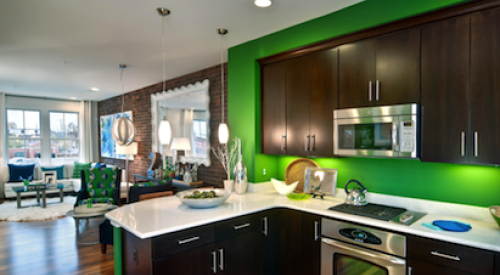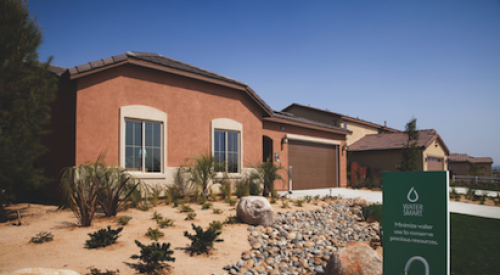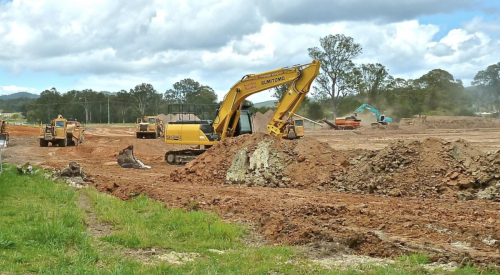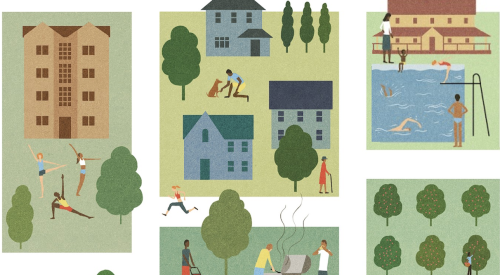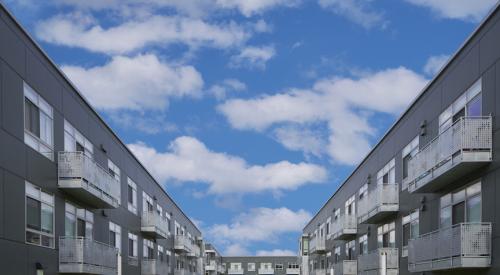|
As the movement of Americans back to the city accelerated in the middle of this decade, many production builders — including public giants such as Pulte Homes, D.R. Horton, K. Hovnanian Enterprises and Toll Brothers — added mid-rise condo apartments to their product lines. A few even started building high-rises. Most of those builders are now nursing the burns such risk-filled ventures inflicted when housing markets began to tank in 2005. But is it possible the pioneers of this diversification into high-density housing forms were not wrong, just premature?
“If gas prices don't come down, cities and towns are going to permanently contract,” predicts Littleton, Col.-based management consultant Chuck Shinn. “High-density development will urbanize our existing suburbs and mid-rises will be a larger percentage of a lot of builders' businesses.”
Nipped in the BudThe housing crash caused large numbers of mid-rise condo projects to be shelved or canceled entirely. “We hired a high-density housing specialist,” says David Weekley, chairman of Houston-based giant David Weekley Homes, No. 19 in Professional Builder's Giant 400 ranking swith $1.34 billion in 2007 housing revenues — all from single-family homes and townhouses. “And we had some mid-rise sites under contract, but the market weakened and we lost our nerve.
“We'd gone all the way through design on some of those deals, but mid-rises are a risky proposition in a bad market,” Weekley notes. “Once you start construction, there's no turning back. You don't have the flexibility that's there in single-family to change a floor plan.” Weekley will do high-density townhouses on one site and sell another to an apartment builder.
All across America, as the housing downturn deepened, condo builders felt the pain. If the builder paid too much for a mid-rise site, there was nothing to do but deep-six the project as housing prices spiraled down. If the builder didn't pull the plug, his lender did. And those problems persist to this day. “It's a long journey from initial project concept and land purchase to closing homes in a mid-rise,” says Tampa, Fla.-based builder marketing consultant John Rymer. “I don't know any lenders, or builders, who have an appetite for that journey in the near term.”
Mid-rise development is in a state of limbo as changing land prices reshape the competitive landscape. “The problem for mid-rises is the surplus of vacant, developed lots in the suburbs,” says South Florida builder Tim Hernandez of New Urban Communities. “They're cheap, and that means single-family builders in the suburbs will soon be offering detached homes at very attractive prices.
“Meanwhile, the mid-rise builders still face high land prices for urban infill sites. Those density-zoned sites will never go for less than the apartment builders are willing to pay for them, and the apartment market is still pretty healthy,” he says. “Then there are the hard costs for building mid-rises, which have been going up exponentially the last few years, especially for structured parking. We looked at deals with densities as high as 60 units per acre, but when you have to pay over $20,000 for a parking space, and the municipality requires two or three spaces per unit, it's hard to make the deal pencil.
“It's tough for a builder to have confidence that buyers will be willing to pay a big premium to live in an urban mid-rise, closer to work, when they have the option to buy a home or townhouse in the suburbs at a bargain price,” Hernandez says, then adds, “They might just go for a townhouse and use the money they save to buy a car that gets 50 miles to the gallon. In order for us to do a mid-rise now, the nearest detached, for-sale homes would have to be very far away.”
Short-Term TroubleUntil inventories of unsold homes decline and lot prices stabilize, the only mid-rises coming out of the ground are likely to be those in “A+” urban locations, close to mass transit lines, shopping, restaurants and nightlife — and far, far away from bargain detached homes and townhouses.
“In a housing recession, the first things that soften are condos, then townhouses, then detached homes,” says Tom Krobot, president of Atlanta-based Ashton Woods Homes, No. 50 in PB's Giant 400 with $493.5 million in 2007 housing revenues. Krobot is one of the pioneers of the movement of single-family builders into mid-rise condo development.
“We started building mid-rises four years ago in Atlanta,” Krobot says. “Some builders who got into it later general contract construction, but we build ours with our own people managing the process. “We've closed 500 mid-rise units in Atlanta in three locations, and we have a huge project in Orlando (Fla.), where we've closed 300 and still have another 150 to go.
“These are units priced from $160,000 to $240,000,” Krobot notes, “and at those prices, many of the buyers are not just lifestyle purchasers. There's an entry-level component, and as detached home and townhouse prices decline, those are the buyers that may go away. The extra price load on a condo flat is the homeowners' association fee and it can be a significant burden.”
Krobot calculates his stacked flats need to carry housing payments 30 percent lower than reasonably close single-family homes to maintain sales velocities at 8 to 15 units a month. “You've got a big infrastructure investment on a 60- or 80-unit building,” he says. “Even with a 50 percent pre-sales requirement to start construction, you're putting 40 specs on the ground all at once, and you don't want to have them for long, so you need velocity.”
The Silver LiningNot all the news is bad. Krobot believes it may take until 2010 for his housing markets to return to some semblance of normality, so he'll wait a while to pull the trigger on purchasing any new mid-rise sites. But he doesn't plan to abandon the business. “We don't need a hot market,” he says, “just a normal one.”
It would help if the apartment builders ran into enough trouble to slow down their aggressive bidding for “A+” infill sites, but even that may not be necessary to jump-start demand for this product.
“Mid-rise will have a place in the emerging market,” says Charlotte, N.C.-based management consultant Chuck Graham, “the only question is, when?”
Timing is the critical issue. It's dicey to fathom when the right time will be to buy sites, especially with inventory issues and impaired land and lots still littering the markets. “For newcomers, the trouble with waiting too long is that, until you get into it, you don't know how long it will take to learn how to do it well. And the right time will be different in every market. In New York and Philadelphia, it may have already passed.”
Housing has always been resistant to change. “But we've never had $4 (a gallon) gas before,” says Ken Love, president of suburban Chicago-based giant Kimball Hill Homes, which hopes to emerge from Chapter 11 court protection by the end of this year. The firm has already built condos in 10- and 12-story buildings in Chicago.
“Walking to the train station to commute and to restaurants for dinner is a lifestyle that appeals to a lot of people right now,” says Love. “And that number will go up if we ever hit $5 (a gallon) gas. We're not doing any mid-rise projects now, but I can tell you that the best-selling project we have in Sacramento (Calif.) is also the densest. When you look at the success Toll has had with condo product in the New York City market, you can see the forces that drive success in this niche.”
Toll StarsThe 800-pound gorilla of traditional home builders making the move into mid-rise condo product is Horsham, Pa.-based, publicly traded giant Toll Brothers, the No. 8 ranked builder in PB's Giant 400 with $4.5 billion in 2007 housing revenues. Although Toll won't reveal how much of that came from its city living division, which builds condos in and around New York City and Philadelphia, it is substantial because the projects just keep coming.
A typical success story is David Spreckelsen's 5th street lofts building in Long Island City, Queens, just across the East River from Manhattan. It's an eight-story, 117-unit building, brand new, but designed to look like an old industrial building retrofitted into lofts. Sales opened in February 2007, and 102 were sold by August 2008 at prices averaging $750 a square foot ($350,000 for a 400-square-foot studio to $1.5 million for a 1,600-square foot three-bedroom apartment).
“There was a rezoning done in 2005 to create residential opportunities,” Spreckelsen explains. “As soon as it went through, we jumped all over this site.” Long Island City had not yet gentrified, Spreckelsen says, but Toll knew it would — especially because the site has Manhattan skyline views and is one subway stop from Grand Central Station. It's a lifestyle sell to high-income yuppies between 25 and 45 years of age. “They have no interest in the suburbs,” he says, “and in Manhattan, they'd pay double our prices.”
Spreckelsen is now working on a 400-unit project in Brooklyn and just broke ground on another project in Manhattan.
Ben Jogodnik has projects farther from Manhattan, but still exclusively in walkable urban settings. “Toll is a luxury builder, and we're probably more selective in our locations than others working in this niche,” he says. “Much of what we do, the rest of the country would call high-rise. They fall under all the high-rise codes. But here in New York City, 12 stories is definitely called a mid-rise.
“A lot of my buyers are move-downs, leaving a 4,000-square-foot home in the suburbs to move into the city, where the action is. “They can't get younger,” Jogodnik says, “so they want to get cooler.”
|
